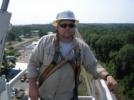Umm another option is to use a huge resistor on the station transformers its connected between the neutral bushing and the earth ground and when a phase does fall the transformer sees it as load as it lays on the ground and no fault current goes back to the transformer, so no fuses blow and service is only interupted from the break on to the end of the line. Ive seen this sceneriao firsthand and it seems to work well I'm sure there must be some drawbacks or it would be more widely used . I just dunno what they are
Results 11 to 18 of 18
Thread: How many have ringed delta?
-
08-31-2014, 11:11 PM #11
 Featured Sponsor
Featured SponsorGuessing you are referring to open wire secondary. Too high of an impedance, thus not enough current flow with secondary voltage to cause any issues with one leg on the ground. A solid phase to phase, or phase to neutral, fault on the secondary side is as likely as not to burn in the clear as to blow secondary fuses, as the transformers are all connected in parallel, thus what is considered basically unlimited available fault current. Regarding blowing both primary and secondary fuses on a transformer failure, majority of transformer faults tend to occur with the breakdown of the insulation on the primary windings. This would cause the primary side fuses to blow. But, remember that there are multiple transformers connected in parallel on the secondary side. This means the other transformers will backfeed into the secondary windings of the faulted transformer, seeing the shorted/grounded primary winding as load. They will pump as much current as possible into the faulted transformer until the fuses on the secondary side blow. And yes, the secondary fuses have indicators that show when the fuses are blown, called by different names such as flags, targets, tattletales, etc. The secondary fuses are replaceable links on a fuse block with a spring loaded indicator, generally in the range of 200 to 800 amps, depending on the kva rating of the transformer. The system really is basically an overhead network system, and any one fault will rarely cause an outage in the system. Nice to know there are other places out there with similar systems. I personally enjoy working on this type of system.
Living my life and loving it!!!
-
08-31-2014, 11:39 PM #12

-
08-31-2014, 11:50 PM #13

Thanks (67),good info you gave us.....but....who comes up with this $hit

-
09-01-2014, 07:08 AM #14
 Senior Member
Senior Member
- Join Date
- Mar 2009
- Posts
- 438
 Henry ford
Henry ford
Henry ford was the head engineer of detroit edison before he started detroit automotive works. Edison gave him the money to start the ford motor company. He had an eighth grade education. I don't know if he designed it or not. Left edison in 1903 or 1905. Super smart guy!
-
09-01-2014, 09:08 PM #15

I don't see where primary laying on the ground hot as being a good system, sounds like a death trap to me.
-
09-02-2014, 12:03 PM #16
 Senior Member
Senior Member
- Join Date
- Mar 2009
- Posts
- 438
 It's like all things
It's like all things
If you are familiar with it and know it, it's a good system. Even the customers know the system, know what to do.
guys work 19.9 in ohio and virginia likes it's no big deal, because the spread is so wide. 10 foot arm +
heard you guys go to steel monopoles and concrete, which is foreign to a lot of people.
detroit you can give people power a lot easier because you have so many options. Options that you will never get from another system. Restoring power is a breeze. And 17 lineman and trimmers have the best reputation in the US. Very few duds. They won't allow it!
-
09-02-2014, 01:36 PM #17
 Tend to agree with LNF
Tend to agree with LNF
If you are solely looking at reliability then I'd say this ringed delta may be better than a grounded wye system. But fuses are generally installed for protection, and not just to protect the system but also to protect the public. Some kid at a bus stop wouldn't understand what was laying there until it was too late.
Not looking for an argument Bobbo, just saying the system wasn't designed with safety in mind. As far as the 17 hands being top notch.... All the ones i've worked with have been!"Never tell people how to do things. Tell them what to do and they will surprise you with their ingenuity."
-
09-02-2014, 09:51 PM #18
 Featured Sponsorr
Featured SponsorrFuses, circuit breakers, reclosers, and such, as well as secondary breakers on csp transformers, none of these are designed or function to protect the public from electrocution. Nor is non reclose, hot line tags, or any other fast trip schemes on utility equipment. All these devices are solely for the protection of equipment from fault or overload conditions. Any utility that has a delta system can have primary laying on the ground, energized, without anything blowing or tripping. Even wye systems can have hot phases laying on the ground energized, looking completely harmless to the public. Even secondaries. Under most conditions, if a hot secondary, even bare open wire, were laying on the ground, without proper test equipment, you have no way of knowing it was energized by looking at it.
From working in Detroit, it is surprising to see how much more people in that city respect the hazard of downed lines, maybe DTE Energy does a much better job of educating joe public. The hazards of energized lines on the ground in Detroit is no different than what you would have on any other system. The biggest hazard is to linemen unfamiliar with Detroit's system, and in not understanding that simply opening a cutout or pulling the secondaries out of the transformer bushings generaly will do absolutely nothing to de-energize part of a circuit. This system is a prime example as to why the first connections to remove when changing out a transformer is the hot legs on the secondaries, as well as the last connections to make when installing a new transformer. There's always a source of backfeed, and you don't want your H1 and H2 bushings energized when making those connections.
It really is a great system, but you need to constantly pay attention to what you are doing, and it is very unforgiving if you try to take shortcuts.Living my life and loving it!!!



 Reply With Quote
Reply With Quote




